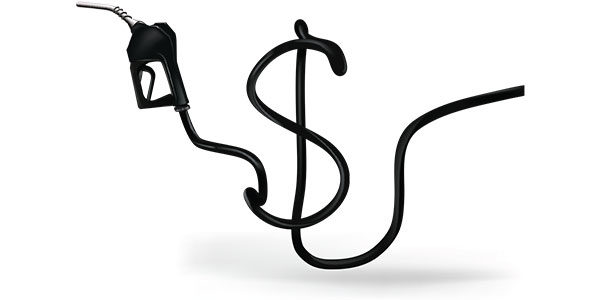The wacky world of diesel fuel surcharges, or "How I learned to hate the peg"

The business of diesel fuel surcharges has grown increasingly complex over their 43-year history and seems to have moved further away than ever from their original purpose, which was to help motor carriers recoup soaring fuel costs triggered by the 1973-74 Arab oil embargo.
Shippers who get hit with the passed-on costs are sympathetic to the carriers' need to manage a cost whose fluctuations are beyond their control. At the same time, they believe the surcharge mechanism has gone from being a clean pass-through of fuel costs to an arbitrage designed to enhance a carrier's revenue and profit. "There are a lot of games that can be played with fuel," said Terri Reid, director of transportation, international and retail logistics, for Caleres, a St. Louis-based footwear company, and a big truck user.
Because surcharges are part of shipper-carrier contracts and are not regulated, the potential for free-market double-dealing is always present. For example, the surcharge formula (more on that below) is based in part on a fleet's fuel efficiency, and many modern-day fleets boast the most efficient trucks in the industry's history. Yet surcharges are based on a lower miles-per-gallon (mpg) threshold that becomes detrimental to the shipper when calculating fuel costs, according to critics.
Large truckers buying fuel in bulk will negotiate huge discounts and rebates from truckstop operators, but then will pocket the difference between their wholesale costs and the surcharge revenue based on a government-published weekly index that prices fuel at the retail level, critics contend.
Some carriers bake surcharges into their base rates, a step that eliminates a shipper's ability to see the charges for a key element of a trucker's pass-through costs. A freight broker working in the spot, or non-contract, arena, which accounts for 25 to 30 percent of the total truckload market, incorporates a fuel surcharge into the total price it offers its shipper customers. As a result, a shipper using a broker doesn't know the impact of fuel on its overall cost.
Larry Menaker, a Chicago-based consultant who has been around the business for decades, said that surcharges, while not perfect, have generally lived up to their original intent. However, Menaker acknowledged that in the $550 billion-a-year truckload sector, where fuel is a significant cost component because of the relatively long lengths of haul, there has been pressure to change "what shippers believe is a broken system." While surcharges in the truckload sector are based on the length of haul, surcharges in the smaller less-than-truckload (LTL) segment are calculated as a percentage of shipment revenue because the haulage lengths are shorter.
SURCHARGES EXPLAINEDSurcharges have three components: An index that sets fuel prices and serves as a benchmark for the surcharges; a "peg" or contractually negotiated price above or below which surcharges are or are not imposed; and an "escalator," which determines the actual surcharge amount based on the average mpg of a carrier's fleet. Most of the industry uses an index published each Monday by the Department of Energy's Energy Information Administration (EIA) that surveys about 400 nationwide locations and determines national and regional prices. The EIA index includes a nationwide average price, as well as prices broken down by various regions.
The "peg" can be set anywhere from zero to more than $2 a gallon, depending on a shipper's volume and its preferences (more about that later). From there, the "escalator" formula kicks in, with a one-cent surcharge imposed for every five or six cents by which prices in the EIA index exceed the peg rate. The surcharge paid by the user is the difference between the peg and EIA prices, multiplied by the miles traveled.
For example, a shipper and truckload carrier agree to a peg price of $1.20 a gallon, a level that is fairly common. If weekly pump prices hit $4 a gallon and the interval of increase is set at 6 cents, the surcharge amount comes to 46.6 cents a mile. A load moving 1,000 miles would thus have a $466 surcharge tacked onto the base rate.
The 5- to 6-cent intervals have held sway for years because they match the historical number of miles a heavy-duty truck traveled on a gallon of fuel. However, truckload fleets with modern equipment get between 6.3 and 6.5 mpg, according to various estimates. Some trucks get as much as 7 mpg, but that isn't the norm.
Because the EIA numbers are nearly always above the pegs, surcharges have become a part of everyday shipping. However, with the weekly EIA nationwide price at $2.07 a gallon, the lowest inflation-adjusted level since December 2002, prices are approaching pegs that have been set at the upper end of the range.
TAKE THIS PEG AND ... !Here's where it gets interesting. Though a higher peg means a smaller fuel surcharge, it also translates into a higher line-haul rate, since the carrier needs to recoup the foregone surcharge revenue one way or another. While a lower peg results in higher surcharges for the shipper, it would, at least in theory, be offset by declines in the base rate because the carriers were receiving more compensation for fuel.
Shipper-carrier contracts effectively become a roll of the dice; pegs are negotiated based in part on fuel price forecasts, which may or may not be accurate, but also on whether a shipper, not wanting to be bothered with fuel price volatility, would rather live with a high peg, pay virtually no fuel surcharges, and work toward negotiating a more favorable line-haul rate. Chris Lee, vice president of Bridge City, Texas-based ProMiles Software, a firm that provides real-time fuel-price tracking for carriers, said shippers in that scenario get a level of fuel price predictability that wouldn't be available with a lower peg and might be willing to absorb higher line-haul rates as a trade-off.
Lee said he knows of a large shipper, which he did not identify, that negotiated a contract for 2016 with a peg price of $2.50 a gallon. With the carrier getting six miles to the gallon, it embeds 41.6 cents a mile into the line-haul rate to cover its imputed fuel cost. However, with fuel prices on its lanes running around $2 a gallon, the carrier's actual fill-up cost is 33.3 cents per mile, Lee estimates. That 8.3-cent-a-mile difference—multiplied by thousands of miles driven—comes out of the shipper's pocket and goes straight to the carrier's bottom line, he said.
The dilemma for shippers is compounded by the variance in prices from, say, the Midwest and Gulf Coast, where diesel is cheaper, to the Northeast, where costs are higher. Fuel for a Dallas-to-Chicago run costs $1.92 a gallon, while a Boston-to Chicago trip clocks in at $2.21, according to ProMiles' current estimates. Yet only 10 miles separate the respective distances, Lee said. If the pegs on each run were the same, the difference in prices could be easily compared, Lee said. Not so, however, if the peg on one lane was set at $1.50 a gallon, and the other at $2 a gallon, he added.
ZERO TOLERANCEMuch of the head-spinning would disappear if the industry eliminated the peg altogether, let surcharges effectively cover all of the fuel cost, and let the chips fall where they may in line-haul rate negotiations, according to several experts. A zero peg eliminates pricing variability and gives carriers an incentive to invest in more fuel-efficient equipment and run their networks more efficiently to reduce wasteful fuel burn, they contend.
"Everything other than a zero base is artificial and manipulated," said Craig Dickman, founder of Breakthrough Fuel LLC, a Green Bay, Wis.-based consultancy that provides shippers with daily fuel pricing across all requested lanes, among other services. Chris Caplice, executive director of the Massachusetts Institute of Technology's Center for Transportation & Logistics, said a zero peg is easy to administer and understand, and imposes needed and beneficial discipline on carriers to improve their operations.
Caplice added that 99 percent of the industry still uses a peg, although several high-profile companies and huge shippers like Charlotte, N.C.-based Chiquita Brands International Inc. and Chicago-based Kraft Heinz Co. have adopted the zero-peg formula. Dickman offers a different view: About 68 percent of its shipper customers don't use a peg, up from 7.5 percent in 2011, he said.
Real-time pricing visibility and transparency, which can only be realized through information technology, is critical to distance the industry from the peg formula. Today, sophisticated tracking software can update diesel prices each day—sometimes multiple times a day—across a network of thousands of truckstops and service stations. At Breakthrough Fuel, shippers transmit their daily lane activity, which Breakthrough then runs through its systems to produce real-time fuel price data at all truckstops appearing on every requested lane. Breakthrough analyzes how fuel taxes, which vary from state to state, affect overall prices and provides market intelligence to accompany the data.
Dickman acknowledged that even sophisticated shippers have said its system takes some getting used to. Eventually, though, they gain better visibility into the role that fuel plays in their cost structure, he said. Dickman said his model goes a step further than a "zero peg" approach by creating a "surcharge free" mechanism for fuel reimbursement based on real-time rates that are sensitive to time, geography, and taxes. A carrier is fairly and accurately reimbursed for its costs based on the way it purchases fuel and pays applicable taxes, he said.
Lee of ProMiles said his firm's database, which can be updated every half hour, covers about 5,000 truckstops and service stations each day, compared with EIA's survey of 400 truckstops and service stations each week. Lee added that ProMiles' surveys exclude truckstops that also pump automotive diesel because those prices tend to skew the overall price trend higher. As a result, the average truck diesel prices in ProMiles' database are usually 2 to 6 cents a gallon below the average EIA prices, he said.
Advocates of the "zero peg" approach said the shift would not save shippers money. Carriers will be paid the same, whether it is in the form of higher fuel surcharge revenue or increased line-haul rates, they said. What will happen, they argued, is that shippers will have the confidence of knowing their fuel costs are exactly what they think they should be, and that both shipper and carrier will gain if fleet and network efficiency are improved.
Related Articles

Copyright ©2024. All Rights ReservedDesign, CMS, Hosting & Web Development :: ePublishing